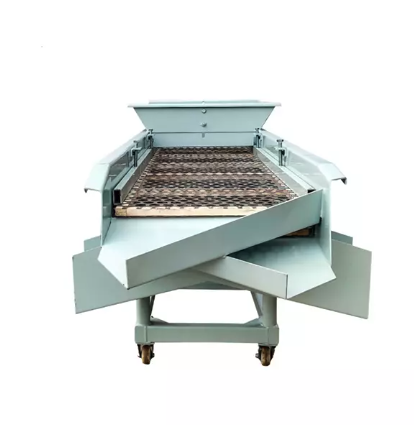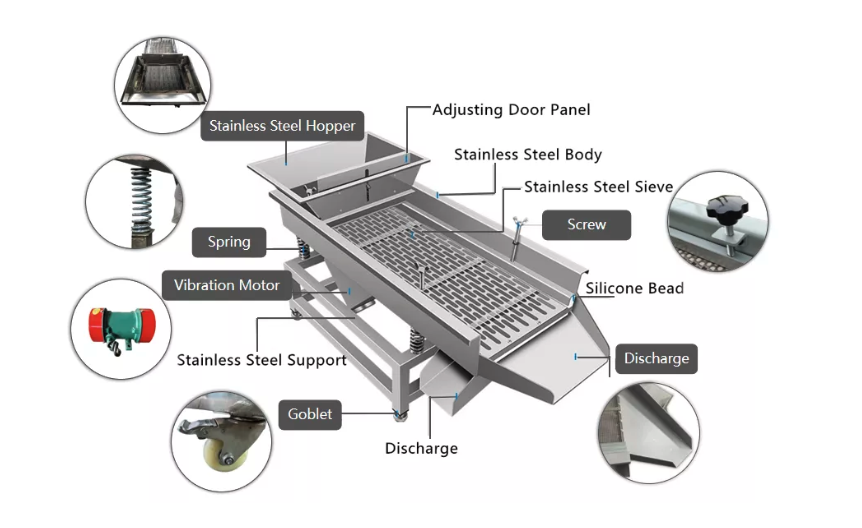- Home
- Machine
- Media
- Application
- Service
- About Us
- Blogs
- Contact Us
- All
- Product Name
- Product Keyword
- Product Model
- Product Summary
- Product Description
- Multi Field Search


Views: 0 Author: Site Editor Publish Time: 2025-10-21 Origin: Site











A linear vibrating screen machine is a versatile and essential piece of industrial equipment designed to sort, classify, and separate materials by size. By creating a linear vibratory motion, the machine moves materials in a straight line across the screen, allowing fine particles to pass through while larger particles continue forward. This process is highly effective for multi-layer screening, making linear vibrating screens an indispensable tool in mining, metallurgy, chemicals, food, pharmaceuticals, plastics, and construction industries. Their ability to support continuous assembly line operations ensures consistent output, high efficiency, and reduced manual labor, making them a smart investment for modern production facilities.
A linear vibrating screen machine is an essential industrial device used for separating, classifying, and sorting materials. It works by generating a linear vibratory motion that propels materials across the screen surface in a straight line, allowing smaller particles to fall through while larger ones move forward. This makes it highly efficient for multi-layer screening, especially in high-volume production environments.
The importance of these machines lies in accurate material classification, industrial screening, and support for continuous assembly line operations. By automatically sorting particles by size, it reduces manual labor, minimizes material loss, and ensures consistent product quality across various applications.
Industries that rely on linear vibrating screens include:
Mining and metallurgy – separating ores, coal, coke, and minerals for further processing
Chemicals and building materials – grading sand, cement, fertilizers, and powders
Food and pharmaceuticals – screening grains, powdered medicine, and other fine materials
Plastics and abrasives – handling granules, powders, and other bulk materials
These machines are often referred to as linear vibrating screens, linear screen machines, or vibrating screen equipment, depending on regional terminology and manufacturer specifications. They are particularly suited for assembly line operations because they enable continuous processing with minimal downtime.

The core of a linear vibrating screen is its dual vibration motor system. Each motor rotates in opposite directions, creating a linear vibration trajectory on the screen surface. Unlike circular vibrating screens, this design allows materials to move straight forward while being repeatedly lifted and dropped, which promotes efficient separation by particle size.
The force generated by the motors interacts with gravity to move particles along the screen. Fine particles gradually pass through the mesh openings of the lower layers, while larger particles continue traveling across the surface. This motion ensures that materials are stratified naturally based on their size and density, which is critical for achieving high-precision screening.
| Component | Function |
|---|---|
| Dual vibration motors | Produce linear vibratory motion |
| Eccentric blocks | Convert rotational energy into vibration |
| Inclined motor shafts | Direct material movement along the screen |
| Screen layers | Separate fine and coarse particles |
This mechanism makes linear vibrating screens ideal for assembly lines, as it ensures continuous material flow and consistent output.
Materials enter the machine through a vibrating feeder and are evenly distributed across the multi-layer screen surface. The separation occurs in several stages:
Large particles remain on top, moving across the screen while being lifted slightly by the vibration.
Small particles pass through the mesh of the first layer and drop to the next, where further separation occurs.
Multi-layer screens allow the machine to simultaneously sort several particle sizes, increasing processing efficiency.
Modern linear vibrating screens incorporate advanced features to improve performance and durability:
Self-synchronized vibration – ensures smooth, stable motion without additional adjustment
Rubber spring damping system – absorbs vibrations to protect machinery and reduce noise
Wear-resistant screen plates – prolong the service life even under heavy-duty applications
Eccentric compression sealing – prevents dust and fine particles from escaping the machine
These features not only increase screening efficiency, but also reduce maintenance costs and extend the machine’s overall lifespan.
A linear vibrating screen machine is composed of multiple carefully designed components that work together to ensure efficient, stable, and precise material separation. Each part is critical for performance, durability, and safety, especially in heavy-duty industrial applications.
The screen box is the central component where the actual sorting and classification of materials occurs. Its design directly affects the screening efficiency and machine longevity. A typical screen box consists of:
Tank body – acts as the main enclosure, providing strength to withstand heavy loads and continuous vibration.
Upper feeding port – ensures materials enter the machine evenly, preventing clumping or uneven distribution.
Screen frame – holds the screen mesh in place securely.
Screen plate or mesh – the actual filtration layer that separates particles based on size.
Lining net – protects the screen surface from wear, especially when handling abrasive materials like ores or sand.
Discharge port – allows processed materials to exit efficiently, preventing blockages.
Most screen boxes are constructed from welded steel plates reinforced with internal ribs. This ensures rigidity under heavy vibration and prevents deformation over long-term use. A well-designed screen box also helps reduce noise, limit dust leakage, and maintain consistent separation quality.
The screen frame serves as the support structure for the screen mesh. It must maintain flatness across the screening surface to ensure even material distribution and precise particle separation. Common materials for the screen frame include:
Pine wood – lightweight, strong, and slightly flexible to absorb vibration
Low-deformation wood – minimizes warping even under long-term heavy use
The frame design allows the mesh to remain taut and prevents sagging, which can reduce screening accuracy. By absorbing vibration stress, it also prolongs the life of both the mesh and the machine.
The choice of screen mesh depends on the material type, particle size, and required separation precision. Options include:
Low-carbon steel mesh – widely used for general-purpose screening and dry bulk materials
Brass or bronze mesh – offers excellent corrosion resistance, suitable for chemical powders or wet materials
Stainless steel wire mesh – ideal for food, pharmaceutical, and high-hygiene applications
The screen can be single-layer for simple separation or multi-layer to classify fine, medium, and coarse particles simultaneously. Multi-layer configurations maximize throughput, reduce the need for multiple machines, and improve production efficiency.
The vibration motor is considered the heart of a linear vibrating screen machine, providing the excitation force needed to move materials along the screen. Key points include:
Top-mounted installation – standard method, ensures even vibration across the screen surface
Side-mounted installation – optional, allows for different vibration angles or specific operational needs
A motor pedestal secures the motor firmly, and bolts must be tightened and checked regularly to avoid loosening, which could compromise screening efficiency, safety, and machine lifespan. The vibration motor design also allows operators to adjust the amplitude and frequency for different materials, improving the machine’s flexibility.
The damping system plays a critical role in minimizing vibration transfer to the ground and surrounding structures, which reduces wear on the machine and prevents structural damage. There are two main types:
Seat type – simple to install and ideal for machines with lower installation heights
Hanging type – more flexible, provides better shock absorption, and is suitable for high-vibration environments
Springs in the damping system support the weight of the screen box while absorbing shocks. This protects the frame, reduces noise, and prolongs the lifespan of both the machine and its components.
The bottom frame and support structure provide the foundation for the entire machine, ensuring stability, alignment, and proper vibration distribution. Functions include:
Supporting the full weight of the screen box and materials
Maintaining alignment so vibration moves efficiently without structural stress
Absorbing and transmitting vibration safely to prevent foundation damage
A robust bottom frame is especially important for machines handling heavy or abrasive materials, ensuring the system remains safe, stable, and operational under continuous use.

Excellent sealing – minimizes dust and powder loss
Low energy consumption and noise – suitable for long-term industrial use
High screening accuracy – fine separation of multiple particle sizes
Large processing capacity – suitable for heavy-duty applications
Simple operation – easy screen replacement and maintenance
Fully enclosed design – automatic material discharge
Durable construction – welded steel plates and reinforced profiles
Versatile applications – handles powders, granules, and bulk materials
Linear vibrating screen machines are widely used across industries due to their high efficiency, precise separation, and adaptability. They help reduce waste, improve product quality, and enable smooth continuous production.
Linear vibrating screens play a crucial role in mining and metallurgy operations, where precise separation of raw materials is required. They are ideal for ore, coal, coke, and mineral particles, ensuring materials are graded to the correct size before further processing such as smelting, crushing, or chemical treatment. By maintaining uniform particle size, the machine protects downstream equipment, reduces wear on crushers and smelters, and enhances overall plant efficiency. Continuous operation allows high-volume throughput, making it suitable for large-scale mining operations.
In the chemical and construction sectors, accuracy and cleanliness are essential. Linear vibrating screens efficiently handle materials like sand, cement, fertilizers, and various chemical powders, separating fine and coarse particles while removing impurities. Multi-layer screening capability allows multiple product grades to be processed simultaneously, reducing the need for separate machines. By maintaining product consistency and preventing contamination, these screens support regulatory compliance and production efficiency, especially in high-capacity manufacturing lines.
Industries with stringent hygiene and quality standards also benefit from linear vibrating screens. They are used for grains, powdered medicine, and plastic granules, ensuring uniform particle size and removing dust or foreign particles. Multi-layer configurations allow simultaneous classification of different grades in one pass. Stainless steel or food-grade screens ensure compliance with hygiene regulations. By providing precise, reliable separation, these screens help manufacturers maintain product quality, reduce waste, and streamline automated production lines.
Across all sectors, linear vibrating screens provide significant operational advantages. They allow high-precision, multi-layer separation, making them suitable for continuous, high-capacity production. By reducing manual handling, they improve workplace safety and lower labor costs. Their energy-efficient design ensures high throughput with minimal power consumption, and their versatile construction allows handling of powders, granules, and bulk materials, including abrasive substances. Overall, linear vibrating screens enhance efficiency, productivity, and product quality in virtually any material-processing industry.
A: Linear vibrating screens typically support 1 to 5 layers, depending on the model and application. Multi-layer screens allow simultaneous separation of fine, medium, and coarse particles, which increases efficiency and reduces the need for multiple machines in production lines.
A: Yes, the machine is designed to handle both powdery and granular materials efficiently. Its vibration amplitude, screen mesh type, and multi-layer configuration can be adjusted to optimize separation and prevent clogging or material loss.
A: The choice depends on the type of material, particle size, and chemical or corrosion resistance required. Common options include low-carbon steel for general use, brass or bronze for chemical resistance, and stainless steel for food, pharmaceutical, or hygienic applications.
A: These machines are designed for low power consumption while maintaining high throughput. Efficient vibration motor systems and optimized structural design reduce energy use and operating costs, making them suitable for large-scale industrial applications.
A: Yes, most linear vibrating screens allow operators to tune vibration frequency and amplitude to match material type and particle size. Adjustments improve screening efficiency, reduce wear, and minimize material loss.
In summary, a linear vibrating screen machine provides high-precision material separation, multi-layer screening, and energy-efficient operation across a wide range of industries. From ore and coal processing to chemical powders, grains, and plastic granules, it ensures materials are consistently classified and ready for further processing. For manufacturers seeking reliable, durable, and high-performing screening solutions, Huzhou Norden Machinery Factory offers expertly engineered linear vibrating screens that combine advanced technology, robust construction, and long service life. Their machines are ideal for continuous production lines, helping businesses improve efficiency, reduce waste, and achieve superior product quality.